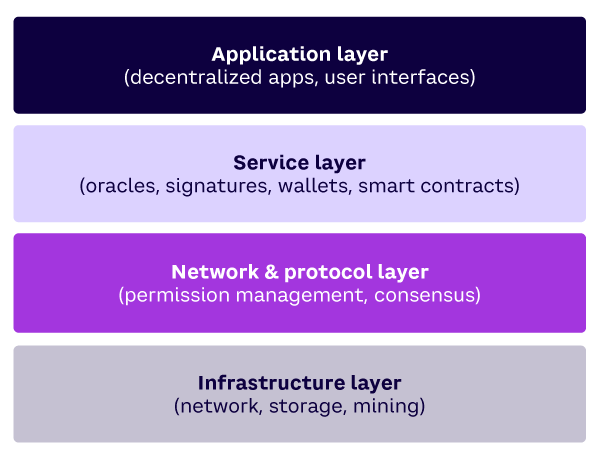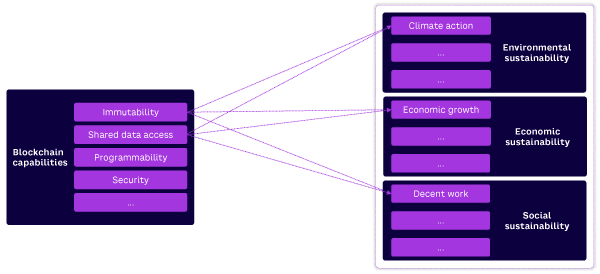Blockchain, a complex technology, and sustainability, an abstract concept, have two things in common: (1) they are fairly comprehensive and (2) vaguely defined. To understand how the former can impact the latter, core terms and existing trade-offs must be properly explained, and all positive or negative blockchain sustainability implications must be carefully evaluated.
Admittedly, the situation is somewhat confusing. If one goes by mainstream media, the idea that blockchains can foster sustainability is an oxymoron. A Forbes article from earlier this year is titled “Why Blockchain, NFTs, and Web3 have a Sustainability Problem,” implying that blockchain itself and the applications built on it pose serious problems for the environment. The article nicely illustrates the problem of blockchain’s media coverage. It’s “the blockchain” that consumes energy, destroys the environment, or (less frequently) helps build innovative and useful solutions.
The truth is that “the blockchain” doesn’t exist. Instead, a wide selection of building blocks can be combined in various ways such that protocols based on distributed ledgers emerge that enable a wide range of hitherto impossible applications.
The fundament of the blockchain technology stack is the infrastructure layer in which, among other things, the rules of a decentralized network are determined, as well as the way data is stored and new coins are mined. Numerous implementation options are available for all these components. Similarly, a multitude of design choices exists for the building blocks of the subsequent layers: network and protocol layer, service layer, and application layer (see Figure 1).

This leads to a modular system in which components can be customized depending on the goals and desired features of a certain application. Importantly, no perfect solution exists, and all the different protocols have their own trade-offs between decentralization, security, and scalability. This is aptly named the “blockchain trilemma.”
Furthermore, the technologies underlying blockchain are under constant development, which renders the idea of a static technology impractical. For the sake of simplicity, in the remainder of this article I use “blockchain” as an umbrella term, but readers should be aware that the respective implementations can substantially differ.
The most interesting and controversial blockchain building block in the context of sustainability is the proof-of-work (PoW) consensus mechanism. Originally designed as an ingenious method to combat junk mail, it was cleverly applied by Satoshi Nakamoto in the Bitcoin protocol to create a network in which consensus can be reached among participants who do not need to know or trust each other.
Such a network even works in the presence of malicious participants, as long as the majority follows the rules. To achieve this, energy is used by so-called Bitcoin miners who compete against each other in the race to create the next block of transactions on the chain, which goes along with an attractive reward that is paid out in newly created bitcoin.1
As Bitcoin’s popularity soared, incentives to spend more and more energy to compete in the race for new coins increased. The desired side effect is that the overall security of the network increases, due to the sum total of energy that goes into it. This led some to conclude that it is the PoW consensus that is causing environmental havoc, but the decisive factor is the popularity of a specific blockchain.
For example, the second most popular PoW cryptocurrency, Dogecoin, only uses a fraction of the energy that goes into Bitcoin. It is therefore PoW in combination with Bitcoin’s high appreciation that induces miners to invest in highly specialized equipment and use substantial amounts of energy to search for new blocks.
Additionally, PoW is just one option to reach consensus in a decentralized network. Alternative approaches such as proof of stake (PoS) rely on selecting validators in proportion to the amount of cryptocurrency they hold (i.e., lock up). Naturally, this approach needs much less energy, and a transition from PoW to PoS is possible, as shown by the Ethereum blockchain in September 2022. According to the Crypto Carbon Ratings Institute (CCRI), this transition reduced energy consumption by 99.988% and its carbon footprint by 99.992%.
However, a change in the consensus mechanism has substantial implications on blockchain governance, which makes PoW and PoS hard to compare.2 In light of the overall complexity and the numerous trade-offs, how can blockchain be used to create solutions that help to address at least one of the suggested sustainability goals? I argue that a multitude of options exists by simply combining the advantageous properties of blockchain with their respective sustainability goals. The most reasonable way is to look beyond the technical details of a specific implementation and focus on the emergent capabilities instead.
Figure 2 shows examples of such capabilities, including the immutability of stored data, shared access to data in real time, programmability with the help of short self-executing programs called “smart contracts,” and increased security through encryption and clearly specified data-access roles.
These capabilities must be scrutinized to determine how they can enable and drive the respective sustainability goals, some of which are shown on the right-hand side of Figure 2. For example, the arrows illustrate how the combination of data immutability and shared data access can facilitate positive environmental, economic, and social impact via the traceability of goods.

Notes
1 The upper case “Bitcoin” refers to the network or the protocol; the lower case “bitcoin” denotes the cryptocurrency.
2 For more on the pros and cons of Bitcoin’s energy consumption, see: Treiblmaier, Horst. “A Comprehensive Research Framework for Bitcoin’s Energy Use: Fundamentals, Economic Rationale, and a Pinch of Thermodynamics.” Blockchain: Research and Applications, forthcoming 2023.
[For more from the author on this topics, see: “Sustainability Impact of Blockchain: High Hopes & Great Fears.”]



